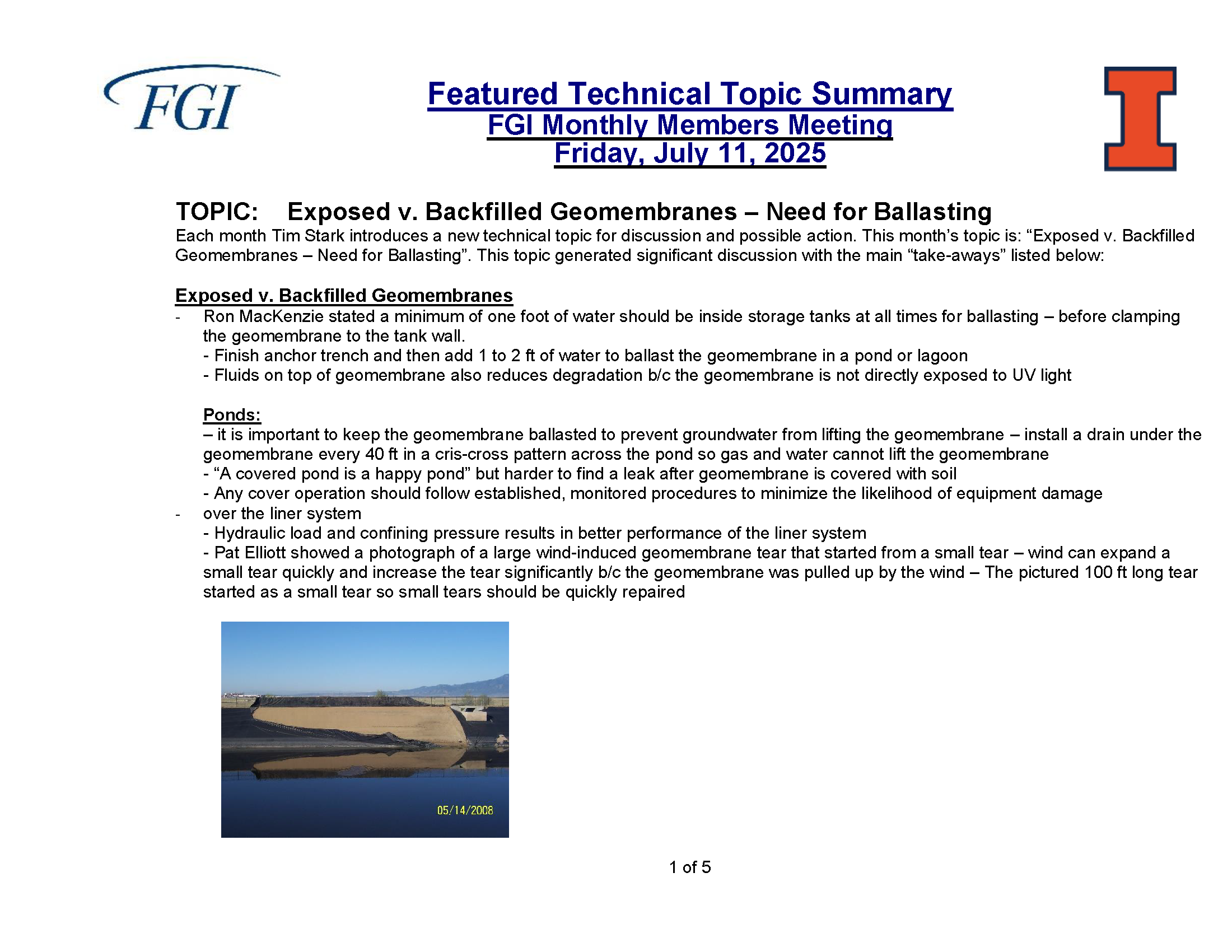
Each month Tim Stark introduces anew technical topic for discussion and possible action. This month’s topic is: “Exposed v. Backfilled Geomembranes – Need for Ballasting”. This topic generated significant discussion with the main “take-aways” listed below:
Exposed v. Backfilled Geomembranes
- Ron MacKenzie stated a minimum of one foot of water should be inside storage tanks at all times for ballasting – before clamping the geomembrane to the tank wall.
- Finish anchor trench and then add 1 to 2 ft of water to ballast the geomembrane in a pond or lagoon
- Fluids on top of geomembrane also reduces degradation b/c the geomembrane is not directly exposed to UV light
Ponds:
– it is important to keep the geomembrane ballasted to prevent groundwater from lifting the geomembrane – install a drain under the geomembrane every 40 ft in a criss cross pattern across the pond so gas and water cannot lift the geomembrane
- A covered pond is a happy pond” but harder to find a leak after geomembrane is covered with soil
- Any cover operation should follow established, monitored procedures to minimize the likelihood of equipment damage
- over the liner system
- Hydraulic load and confining pressure results in better performance of the liner system
- Pat Elliott showed a photograph of a large wind-induced geomembrane tear that started from a small tear – wind can expand a small tear quickly and increase the tear significantly b/c the geomembrane was pulled up by the wind – The pictured 100 ft long tear started as a small tear so small tears should be quickly repaired
- Use 6” – 8” diameter ballast tubes every 25 ft to ballast a geomembrane – tubes are filled with pea gravel
- Place rub-sheet under the ballast tube to protect the geomembrane b/c tube may damage the geomembrane and then strap or weld rub-sheet and possibly the tube to the geomembrane
- Pat Elliott showed 6 ft long and 6” diameter ballast tubes to ballast a geomembrane down a side slope – place long tubes along the slope toe and down the middle of a geomembrane panel
- Ron Frobel can design wind uplift systems – This is good future webinar topic
- Long-term sandbag with reinforced polypropylene geomembrane can have a design life of 5 to 10 years
- Temporary sandbags = 6 months to 1 year – usually filled with sand instead of pea gravel
- Another ballasting option is a chain attached to a concrete curb that runs around the pond. The chain extends all the way down the side slope and ballast tubes are connected to the chain at a required spacing to ballast the geomembrane, A reinforced polypropylene geomembrane is used to make the tubes – chain is connected to a curb outside of the anchor trench& a cap strip is welded from the anchor trench to the curb so chain is not in contact with containment geomembrane
- Other ballasting options are Wind Defender geotextile or Platypus anchors
Above Ground Storage Tanks:
- Brian Fraser next showed photographs of ballasting above ground storage tanks (AGSTs)
- AGSTs can be quite large –perimeter wall should be ballasted – ballast along tank wall with vinyl tubes filled with a liquid or water – also ballast floor and wall connection with tubes
- For larger tanks, the floor has to be ballasted too
- Ballast with 6” – 8” diameter tubes filled with pea gravel or grout with a20” wide wear strip or rub-sheet below the ballast tubes to protect the geomembrane – wear strip should be welded the geomembrane
- Also need to ballast floating covers – keeps wrinkling of the geomembrane cover to a minimum
Click Download for full article, including photos